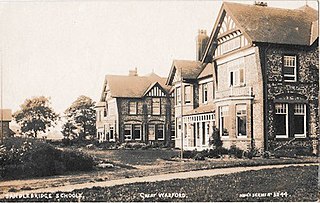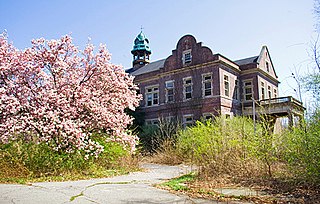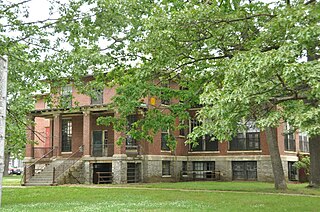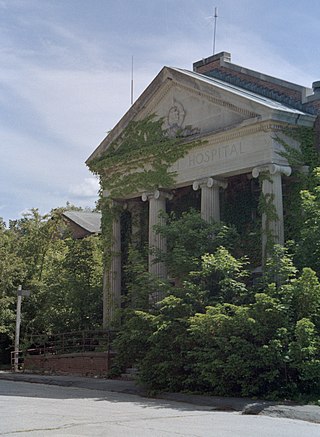
The Walter E. Fernald State School, later the Walter E. Fernald Developmental Center, was the Western hemisphere's oldest publicly funded institution serving people with developmental disabilities. Originally a Victorian sanatorium, it became a "poster child" for the American eugenics movement during the 1920s. It later was the scene of medical experiments in the 20th century. Investigations into this research led to new regulations regarding human research in children.

Tewksbury Hospital is a National Register of Historic Places-listed site located on an 800+ acre campus in Tewksbury, Massachusetts. The centerpiece of the hospital campus is the 1894 Richard Morris Building.

The California School for the Blind is a public educational institution for blind children, K-12, located in Fremont, California. Its campus is located next to the California School for the Deaf.

The Mary Dendy Hospital was a hospital for the "mentally subnormal" located in Great Warford, Cheshire, England.

Pennhurst State School and Hospital, originally known as the Eastern Pennsylvania State Institution for the Feeble-Minded and Epileptic was a state-run institution for mentally and physically disabled individuals of Southeastern Pennsylvania located in Spring City. After 79 years of controversy, it closed on December 9, 1987.

The Rosewood Center was an institution for people with developmental disabilities located on Rosewood Lane in Owings Mills, Maryland.

The Brattleboro Retreat is a private not-for-profit mental health hospital that provides comprehensive inpatient, partial hospitalization, and outpatient treatment services for children, adolescents, and adults.

The South Carolina State Hospital was a publicly funded state-run psychiatric hospital in Columbia, South Carolina. Founded in 1821 as the South Carolina Lunatic Asylum, it was one of the first public mental hospitals established in the United States. The Mills Building, its first building, was designed by early American architect Robert Mills, and is a National Historic Landmark. The hospital had more than 1,000 patients in 1900, but with the transition of mental health facilities to community settings, it closed in the late 1990s. While buildings on the campus were temporarily used for inpatient services into the early 2000s, they were not part of the State Hospital, but other inpatient facilities of the agency. Several buildings on its campus housed offices and storage facilities of the state's Department of Mental Health until approximately 2014. In October 2014, the Department sold the first parcels of the property into private ownership and received the first sale proceeds. The William S. Hall Psychiatric Institute remained on the campus until 2015, when it moved to a new facility on Department's Northeast Columbia Campus. As of January 2021, 100% of the South Carolina State Hospital property had been transferred to private ownership. Proceeds from the sale of the Bull Street property must be used to benefit patients of the Agency. As of August 2020, the SC Mental Health Commission had authorized the expenditure of $10 million of the proceeds, $6.5 million, for the development of additional community housing for patients.

The Wrentham Developmental Center, formerly Wrentham State School, is a historic state-run medical facility for the treatment of psychiatric and developmental disorders. It is located on a large campus at the junction of Emerald and North Streets in Wrentham, Massachusetts. The school was authorized by the state in 1906, and the first phase of the campus was developed between 1909 and 1917. The school opened in 1910. The school had a typical patient population of 1,200-1,300 during the 1920s. The name was changed in the 1990s. The school campus was added to the National Register of Historic Places in 1994.

The Mansfield Training School and Hospital was a state school for people with developmental disabilities located in Mansfield, Connecticut, United States. It was active from 1860 to 1993. Its former campus, located at the junction of Connecticut Route 32 and United States Route 44 in Mansfield is a 350-acre (140 ha) historic district that was listed on the National Register of Historic Places in 1987.

The Fairview Training Center was a state-run facility for people with developmental disabilities in Salem, Oregon, United States. Fairview was established in 1907 as the State Institution for the Feeble-Minded. The hospital opened on December 1, 1908, with 39 patients transferred from the Oregon State Hospital for the Insane. Before its closure in 2000, Fairview was administered by the Oregon Department of Human Services (DHS). DHS continued to operate the Eastern Oregon State Hospital in Pendleton until October 31, 2009.

Central State Hospital, originally known as the Central Lunatic Asylum, is a psychiatric hospital in Petersburg, Virginia, United States. It was the first institution in the country for "colored persons of unsound mind".

Vermont State Hospital, alternately known as the Vermont State Asylum for the Insane and the Waterbury Asylum, was a mental institution built in 1890 in Waterbury, Vermont to help relieve overcrowding at the privately run Vermont Asylum for the Insane in Brattleboro, Vermont, now known as the Brattleboro Retreat. Originally intended to treat the criminally insane, the hospital eventually took in patients with a wide variety of problems, including mild to severe mental disabilities, epilepsy, depression, alcoholism and senility. The hospital campus, much of which now houses other state offices as the Waterbury State Office Complex, was listed on the National Register of Historic Places in 2016. Partly as a replacement for this facility, the state currently operates the 25 bed Vermont Psychiatric Care Hospital in Berlin, Vermont.

Letchworth Village was a residential institution located in Rockland County, New York, in the hamlet of Thiells built for the physically and mentally disabled of all ages, from the newborn to the elderly. Opened in 1911, Letchworth Village at its peak consisted of over 130 buildings spread out over many acres of land. It was named for William Pryor Letchworth, who espoused reform in the treatment and care of the insane, epileptics, and poor children.

The Virginia State Colony for the Epileptics and Feeble Minded was a state run institution for those considered to be “Feeble minded” or those with severe mental impairment. The colony opened in 1910 near Lynchburg, Virginia, in Madison Heights with the goal of isolating those with mental disabilities and other qualities deemed unfit for reproduction away from society. The colony was the home of Carrie Buck, the subject of the landmark Supreme Court case Buck v. Bell.

The Templeton Developmental Center was a state-run facility for mentally disabled people located in Templeton, in the U.S. state of Massachusetts. Founded as the Templeton Farm Colony in 1899 through the efforts of Walter E. Fernald, superintendent of what is now called the Fernald School in Waltham, Massachusetts, it was considered an innovative and progressive facility for managing the state's developmentally disabled population at the time. The large facility was closed in 2015, with some intermediate care facilities remaining open on the campus. The property and some of the buildings were listed on the National Register of Historic Places in 1994.

The Washington State School for the Blind, formerly known as the Washington School for the Blind, is a school for visually-impaired, blind, or deaf-blind students, located in Vancouver, Washington in the United States. The school building was added to the National Register of Historic Places in 1993.

The Little Campus is a historic district and part of the University of Texas at Austin campus in Austin, Texas. Originally built in 1856 as the Texas Asylum for the Blind, the complex was used for a variety of purposes through the late nineteenth and early twentieth centuries. It was acquired by the University of Texas after World War I and listed on the National Register of Historic Places in 1974.

The State Home and School for Dependent and Neglected Children was a state institution for children in Providence, Rhode Island. Following the American Civil War, states assumed new responsibilities for the care of adults and children living in poverty or with serious illnesses. The State Home, and organizations like it across the country, sought to remove dependent children from adult correctional institutes, almshouses, and juvenile reformatories. It was located on a cottage-plan campus in what was originally rural western Providence, on a former gentleman's farm. The school was established in 1884 and operated until 1979, when its remaining functions were taken over by other state organizations. Most of its surviving grounds and buildings are now on the Rhode Island College East Campus, and have been listed as a historic district on the National Register of Historic Places.
State schools are a type of institution for people with intellectual and developmental disabilities in the United States. These institutions are run by individual states. These state schools were and are famous for abuse and neglect. In many states, the residents were involuntary sterilized during the eugenics era. Many states have closed state schools as part of the deinstitutionalisation movement.






















